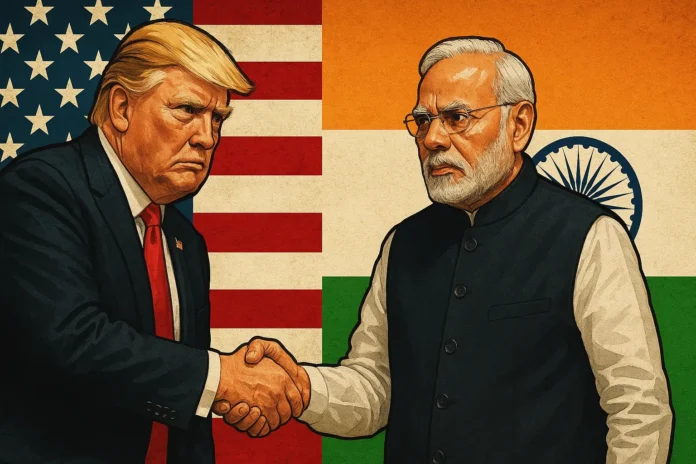SUMMARY
- Trump says India must open up or face renewed 26% tariffs as the July 9 deadline nears.
- India holds firm on agriculture, especially dairy, while pushing for textile and seafood access.
- A failure to strike a deal could derail the ambitious $500B bilateral trade target for 2030.
A Deal or a Deadline: The Stakes of the US–India Tariff Truce
With a July 9 deadline approaching, trade negotiators in Washington are in a high-stakes sprint to finalize a Bilateral Trade Agreement (BTA) between India and the United States. Triggered by a temporary 90-day pause on escalated tariffs, the talks have taken a sharp political turn. US President Donald Trump, doubling down on his hardline rhetoric, has declared that India must either allow more open market access—especially for American agricultural exports—or face a sharp return to punitive tariffs.
Behind the urgency lies a broader ambition: to raise bilateral trade from the current $191 billion to $500 billion by 2030. But agriculture, not ambition, is proving to be the real sticking point. Trump has signaled that the US is ready to strike a deal “with much less tariffs,” but only if India reduces longstanding barriers to American goods. Meanwhile, India’s negotiators, under increasing domestic pressure, are unwilling to compromise on dairy and other politically sensitive sectors. This editorial unpacks what’s at stake as the world watches one of the largest trade relationships teeter between escalation and agreement.
Heard that Piddis've consumed Fevicol after hearing this. Afterall, their new illegitimate father…Trump is stunned by #Modi Sarkar over 'Trade Deal'!
— BhikuMhatre (@MumbaichaDon) July 1, 2025
Bharat–US trade talks hit stalemate over agriculture, dairy & GM crops, as Bharat refuses to bow to any pressure.
Reasons-
👉… pic.twitter.com/9nihM00AS6
Trump’s Trade Ultimatum: “Much Less Tariffs—If India Lets Us Compete”
- Trump says India blocks US market access, proposes major tariff reduction conditional on deal.
- Criticizes India’s “high barriers,” especially on auto and agricultural imports.
- Suggests US will impose up to 26% tariffs if talks fail by July 9.
In his recent remarks, President Trump signaled a sharp pivot from diplomacy to economic coercion. “Right now, India does not accept anybody in,” he told reporters in Washington, before adding, “If they do that, we are going to have a deal for much less tariffs.”
Trump’s administration had temporarily paused 26% reciprocal tariffs imposed during his previous tenure, granting negotiators a 90-day window. That window slams shut on July 9—and Trump appears uninterested in extending it. Instead, he’s suggested a unilateral tariff notification approach, threatening to apply 25% or higher tariffs to imports from countries that don’t meet US expectations.
India, a key trade partner and strategic ally, has been called out specifically. Trump’s characterization of India as “a country that doesn’t let anybody compete” underscores the depth of frustration in Washington, particularly over India’s closed dairy sector, high tariffs on auto imports, and technical barriers affecting genetically modified crops.
India Pushes Back: Agriculture Is Non-Negotiable
- India refuses to open dairy sector, citing small-scale farmers and food safety concerns.
- Seeks preferential access for textiles, shrimp, bananas, and gems.
- Indian team extends stay in Washington as negotiations stretch into overtime.
On the Indian side, the tone is less theatrical but equally resolute. Sources within the Indian delegation confirmed that agriculture—especially dairy—remains a red line. India’s smallholder farming model makes any liberalization politically risky, with rural constituencies already stressed by inflation and extreme weather events.
India has never opened its dairy sector in any prior free trade agreement—and negotiators are wary of setting a precedent under US pressure. Instead, New Delhi has pushed for improved market access for labor-intensive exports like textiles, leather, and seafood—sectors critical for job creation.
Yet, as both sides push competing priorities, time is running out. The Indian team, led by Chief Negotiator Rajesh Agrawal, has already extended its stay in Washington in hopes of bridging the gap. Talks that were scheduled to end last Friday are now continuing in a round-the-clock fashion, but officials on both sides concede the outcome remains uncertain.
Deal or Breakdown: What the Deadline Means for Global Trade
- If no agreement is reached, 26% tariffs will automatically reapply.
- The failure could derail the $500B trade target and damage global supply chains.
- Business groups urge compromise to avoid renewed trade shocks.
Beyond the geopolitics and domestic constraints, there’s a broader question looming: what happens if the July 9 deadline passes without a deal?
According to US officials, the suspended tariffs—first imposed on April 2 during Trump’s first term—would automatically return. This would significantly raise the cost of trade between the two nations, affecting sectors from electronics to almonds.
India, already battling a complex global trade environment involving tensions with China and disruptions from the Iran conflict, cannot afford another shock. US business groups, too, are worried. Organizations such as the US-India Business Council have urged both sides to focus on “strategic patience and long-term alignment” rather than tactical brinkmanship.
Meanwhile, both governments are aware that a breakdown now could delay broader plans to finalize a comprehensive BTA by fall 2024, jeopardizing the longer-term $500B trade goal.
Rebalancing, Not Retreat: What This Deal Really Symbolizes
In the larger scheme, this is not just about soybeans and shrimp. The India–US trade negotiations are a reflection of two democracies trying to recalibrate economic alignment without yielding to domestic political flashpoints. For the US, the tariff threats are part pressure tactic, part populist signaling. For India, refusal to bend on agriculture is as much about sovereignty and electoral politics as it is about trade.
Yet behind the public posturing lies a recognition of mutual necessity. With China’s trade dominance under scrutiny and global supply chains seeking alternatives, the US and India stand to gain enormously from a stable, rules-based, and mutually respectful agreement.
Whether they seize this moment—or squander it under the weight of politics—will determine not just tariff schedules, but the future architecture of Indo-Pacific trade.


